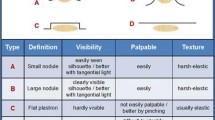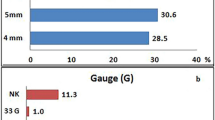Abstract
Aims
Lipohypertrophy (LH) represents the most common skin-related complication associated with insulin therapy. Our aim is to estimate the prevalence of LH among insulin-treated patients, to identify its association with errors in insulin injection technique and storage, and the correlation between LH, risk of hypoglycemia, and glycemic control.
Methods
Consecutive patients with T1DM or T2DM, attending a diabetes clinic for a routine visit, were administered an anonymous questionnaire investigating the modalities of insulin injection, the correct use of pen device, insulin storage, and reported frequency of hypoglycemic episodes. The presence of LH was assessed by inspection and palpation of injection sites.
Results
Overall, 352 patients were enrolled (mean age 68 ± 12 years, 43.2% males, 88.9% with T2DM, mean duration of insulin therapy 9.1 ± 8.6 years). The prevalence of LH was 42.9%. At multivariate analysis, the strongest correlates of LH were not spacing injections (OR 20.4; 95% CI 10.5–39.6) and not rotating the site of injection (OR 2.01; 95% CI 1.08–3.75). Increasing doses of insulin and longer duration of insulin therapy also increased the risk of LH. The presence of LH was associated with a 2.7 times higher risk of severe hypoglycemia. Higher daily insulin doses, lack of rotation of injection sites, and keeping insulin in use in the refrigerator were independent correlates of higher HbA1c levels.
Conclusions
Insulin injection technique is suboptimal in many patients, highlighting the need for improved patient education. Increasing the awareness of the importance of preventing lipohypertrophy and insulin injection errors represents an important tool to reduce the clinical, social, and economic burden of diabetes.
Similar content being viewed by others
References
Gentile S, Strollo F, Ceriello A, AMD-OSDI Injection Technique Study Group (2016) Lipohypertrophy in insulin-treated subjects and other injection-site skin reactions: Are we sure everything is clear? Diabetes Ther 7:401–409
Spollett G, Edelman SV, Mehner P, Walter C, Penfornis A (2016) Improvement of insulin injection technique: examination of current issues and recommendations. Diabetes Educ 42:379–394
De Coninck C, Frid A, Gaspar R et al (2010) Results and analysis of the 2008–2009 Insulin Injection Technique Questionnaire survey. J Diabetes 2:168–179
Johansson UB, Amsberg S, Hannerz L et al (2005) Impaired absorption of insulin aspart from lipohypertrophic injection sites. Diabetes Care 28:2025–2027
Vardar B, Kizilci S (2007) Incidence of lipohypertrophy in diabetic patients and a study of influencing factors. Diabetes Res Clin Pract 77:231–236
Blanco M, Hernández MT, Strauss KW, Amaya M (2013) Prevalence and risk factors of lipohypertrophy in insulin-injecting patients with diabetes. Diabetes Metab 39:445–453
Holstein A, Stege H, Kovacs P (2010) Lipoatrophy associated with the use of insulin analogues: a new case associated with the use of insulin glargine and review of the literature. Expert Opin Drug Saf 9:225–231
Famulla S, Hövelmann U, Fischer A et al (2016) Insulin injection into lipohypertrophic tissue: blunted and more variable insulin absorption and action and impaired postprandial glucose control. Diabetes Care 39:1486–1492
Frid AH, Kreugel G, Grassi G et al (2016) New insulin delivery recommendations. Mayo Clin Proc 91:1231–1255
AMD-OSDI-SID—Raccomandazioni per una corretta tecnica iniettiva e per la prevenzione delle lipodistrofie e del rischio di punture accidentali a cura di un tavolo di lavoro di esperti AMD-OSDI-SID. http://www.aemmedi.it/files/Linee-Guida_Raccomandazioni/2015/ Documento_di_consenso_2015.pdf
Associazione Medici Diabetologi (AMD)—Società Italiana di Diabetologia (SID); Standard italiani per la cura del diabete mellito 2016 http://www.standarditaliani.it/skin/www.standarditaliani.it/pdf/STANDARD_2016_June20.pdf
Gentile S, Strollo F, Guarino G et al (2016) Factors hindering correct identification of unapparent lipohypertrophy. J Diabetes Metab Disord 3:00065
Gentile S, Guarino G, Giancaterini A, Guida P, Strollo F, AMD-OSDI Italian Injection Technique Study Group (2016) A suitable palpation technique allows to identify skin lipohypertrophic lesions in insulin-treated people with diabetes. Springerplus 5:563
Grassi G, Scuntero P, Trepiccioni R, Marubbi F, Strauss K (2014) Optimizing insulin injection technique and its effect on blood glucose control. J Clin Transl Endocrinol 1:145–150
Strauss K, De Gols H, Hannet I, Partanen TM, Frid A (2002) A pan-European epidemiologic study of insulin injection technique in patients with diabetes. Pract Diabetes Int 19:71–76
Berard L, Cameron B (2015) Injection technique practices in a population of Canadians with diabetes: results from a recent patient/diabetes educator survey. Can J Diabetes 39:146–151
Ji J, Lou Q (2014) Insulin pen injection technique survey in patients with type 2 diabetes in mainland China in 2010. Curr Med Res Opin 30:1087–1093
Mitchell VD, Porter K, Beatty SJ (2012) Administration technique and storage of disposable insulin pens reported by patients with diabetes. Diabetes Educ 38:651–658
Strollo F, Guarino G, Armentano V et al (2016) Unexplained hypoglycaemia and large glycaemic variability: skin lipohypertrophy as a predictive sign. Diabetes Res Open J 2:24–32
Author information
Authors and Affiliations
Corresponding author
Ethics declarations
Conflict of interest
None.
Human and animal rights
All procedures followed were in accordance with the ethical standards of the responsible committee on human experimentation (institutional and national) and with the 1975 Declaration of Helsinki, as revised in 2008 (5).
Informed consent
Informed consent was obtained from all patients for being included in the study.
Additional information
Managed by Massimo Porta.
Electronic supplementary material
Below is the link to the electronic supplementary material.
Rights and permissions
About this article
Cite this article
Pozzuoli, G.M., Laudato, M., Barone, M. et al. Errors in insulin treatment management and risk of lipohypertrophy. Acta Diabetol 55, 67–73 (2018). https://doi.org/10.1007/s00592-017-1066-y
Received:
Accepted:
Published:
Issue Date:
DOI: https://doi.org/10.1007/s00592-017-1066-y




